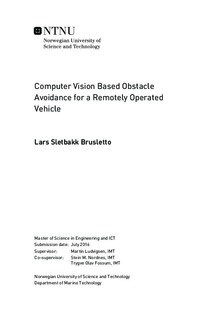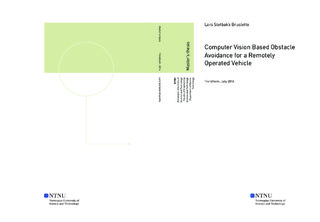| dc.description.abstract | Remotely Operated Underwater Vehicle (ROV) has been operating for many years. The use of ROV is increasing with the increased activities in sub-sea operations. These operations are today dominated by oil and gas offshore activities, aquaculture and mining industry.
There exist a large potential in automating repetitive tasks, for example getting the ROV to the operational destination. It is a good starting point for developing a system to automate that process. Such an ROV`s are operated by a person. The purpose of this thesis is to develop a system that can allow this ROV to move towards its desired destination and to find a method to avoid obstacles which might be present under water
A common sensor for almost all ROV`s is the camera. Therefore, it is advantageous to develop a system that utilizes these cameras. Another benefit is the huge amount of research and tools that are already accessible from the field of computer vision. The camera is a cheap sensor, and it is already on all ROV`s. The main benefits are the vast amount of research and tools already accessible from the field of computer vision.
The challenge is how to benefit from this sensor. This sensor can observe lights in color and brightness. This thesis evaluates different methods of analyzing images and developing methods to use the signals to avoid obstacles when it moves underwater
Three methods have been developed. One method uses two cameras(disparity method). The two other methods need only one camera. Part of the work was concerned with developing a simulation environment to test different computer vision methods for (AUR-lab).
This simulation environment is called AURlabCVsimulator. All methods have been successfully tested in the simulation while the disparity method has been proved to work underwater in Trondheimsfjorden. During this trial in Trondheimsfjorden, the ROV operated and detected an obstacle and its center and gave directions to the control program to exit path.
This trial demonstrates that cameras can be used for underwater obstacle avoidance. Further work can be extended to more sophisticated methods and learn how to read textures such as pipelines, subsea equipment and fishing equipment.
There are many interesting applications and options for further work on the methods in this thesis. | |

